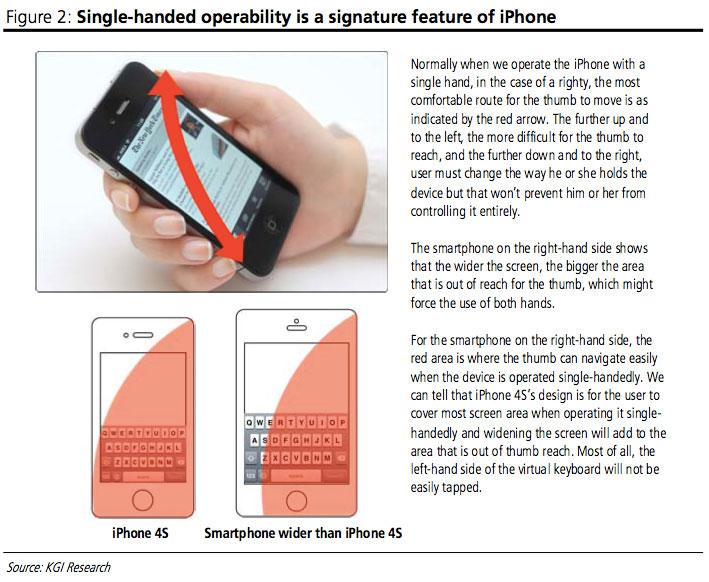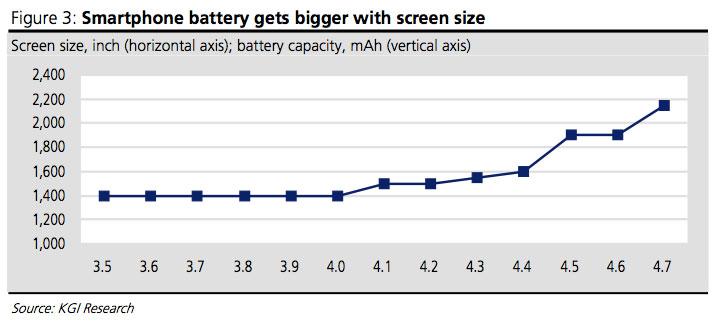26% larger 16:9 iPhone screen would retain single-hand operability
Last updated
As reported earlier Wednesday by AppleInsider, Apple's next iPhone is expected to have a new display with an exact size of 4.08 inches. It will remain a Retina display with a resolution of 1,136 by 640 pixels and an aspect ratio of 16 to 9, according to KGI analyst Ming-Chi Kuo.
By retaining a screen width of 640 pixels, the next iPhone is expected to grow only in length. At an estimated 1,136 pixels tall, it would become a 16-to-9 display, an aspect ratio the same as high-definition TV content and HDTV sets.
But more importantly than the ability to natively view 16-to-9 content, the 4.08-inch iPhone screen would also allow users to continue to operate Apple's handset by using just one hand. According to Kuo, Apple takes single-handed use of the iPhone "very seriously," and wishes to maintain that ability with its next handset.
On smartphones wider than the iPhone 4S, it becomes more difficult for users to safely hold the handset in their hand while simultaneously stretching their thumb across to operate it. The wider the screen, the larger the potential for an area of the screen to become out of reach, requiring users to use two hands to operate the device.
The width of the screen is of particular importance when typing on the virtual keyboard in iOS. If Apple were to increase the width of the display, a right-handed user might have difficulty reaching letters on the left side of the keyboard when operating with a single hand.
The larger 16-to-9 screen could also make typing on the virtual keyboard easier when the handset is used with two hands in landscape mode. The additional space in that orientation would make the individual keys larger and easier to hit.
While the user interface is said to be the driving force behind Apple switching to a 16-to-9 screen with the same width, it is not the only benefit that could be seen with a display that measures 4.08 inches diagonally. Keeping the width of the next iPhone screen the same 640 pixels would also ensure that existing iOS applications written for the iPhone 4S and prior will still run on the device, simply with black "letterbox" bars on the top and bottom.
"If developers don't want to adapt software for iPhone 5, the App can still successfully show on the screen except for the blackened areas on two flanks," Kuo wrote. "That, however, won't prevent the app from functioning the way it's supposed to."
Kuo also doesn't think Apple will go any larger than a 4.08-inch diagonal display because of battery life. A KGI Research survey of smartphone screen sizes and accompanying battery sizes found that batteries in smartphones with 4.3-inch displays must be "visibly bigger" to provide enough uptime.
For example, Kuo noted the the iPhone 4S and its 3.5-inch display has a battery capacity of 1,430mAh, while the 4.3-inch HTC sensation has a battery capacity of 1,520mAh, the 4.5-inch Sony Xperia ion is 1,950mAh, and the 4.7-inch LG Optimus 4X HD is 2,150mAh.
With a 4.08-inch screen, the new iPhone will presumably also become longer. Kuo said this should provide a better phoning experience for users, as the handset's speaker will be located slightly closer to the mouth when the iPhone is held up to the ear.
The next iPhone screen is also expected to use in-cell touch panels that will make it 0.4 millimeters thinner. A new metal back could result in further reduced thickness of 0.96 millimeters, which would allow the next iPhone to measure just 7.9 millimeters thick —noticeably thinner than the 9.3-millimeter-thick iPhone 4S.
In all, the 4.08-inch display rumored to be the centerpiece of Apple's next iPhone would be 26 percent larger than the screen found on the iPhone 4S. Packing 320 pixels per inch, it would have a length of 90.3 millimeters, and a width of 50.9 millimeters.
 Neil Hughes
Neil Hughes















 Amber Neely
Amber Neely
 Thomas Sibilly
Thomas Sibilly
 AppleInsider Staff
AppleInsider Staff
 William Gallagher
William Gallagher
 Malcolm Owen
Malcolm Owen
 Christine McKee
Christine McKee










126 Comments
Still completely unsold on 16:9. Will continue to be unsold on it after launch.
But as long as I don't have to slide my hand up and down the thing like a TV remote, I'll give it a go, I guess.
I guess all those crappy 16:9 4in Android phones were ahead of their time 2 years ago?
That's an interesting article. I buy the battery life thing, but do Apple really need to worry so much about one handed use?
Out of interest, how many people find their interaction with the iPhone is with one hand? Personally, with the exception of answering a call, I never use it with only one hand.
I guess all those crappy 16:9 4in Android phones were ahead of their time 2 years ago?
Large screen is not the issue. Larger case is the problem!
Apple, welcome to the world of shovel-phones!
I guess all those crappy 16:9 4in Android phones were ahead of their time 2 years ago?
Don't you know anything. It's not size that matters, it's what you do with it that counts.